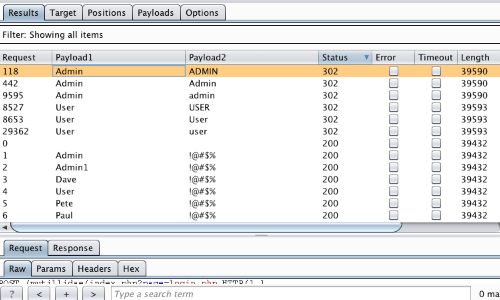


It is interesting to note that this action will send more than the request, as the base unit in Burp Suite is the exchange (a request + a response). The most common way to initialize an Intruder tab is to use the contextual menu (action “ Send to Intruder”) or the corresponding keyboard shortcut (by default “ Control-I”).
#BURP INTRUDER ATTACK TYPES HOW TO#
How to prepare an Intruder attack?īefore processing responses, we first have to emit some traffic. Here’s the TL DR version: ensuring that an attack run as expected, as well as analyzing responses for small differences, should be considered as core tasks and planned accordingly. From my experience, the best way to identify such anomalous responses is to map all responses to “known states”, using built-in features like Grep Match and Grep Extract (more on that later). I also think that users should be able, despite large volumes of results, to 1) verify that a scan run correctly 2) identify uncommon responses. Why discussing such a common tool? Because I think that using it at peak efficiency is quite uncommon, and that plenty of subtle bugs were missed for this very reason. In this article, I will discuss Burp Suite’s Intruder, which is one of the most commonly tool of the suite, alongside Proxy History and Repeater. This article is a guest blog post written by Nicolas Grégoire aka Agarri. When is the Pitchfork mode useful? How can we identify interesting security flaws with “Grep Match” and “Grep Extract”? Intruder is more than a simple brute-force tool, and that’s what we’ll see in this blog post. Behind its appearing simplicity, large-scale efficient usage isn’t straightforward and requires some preparation. Add a delay time.Intruder is one of the first tool that any Burp Suite user interacts with. In the resource pool settings, select Delay between requests, then Increase Go to the Intruder > Resource pool tab.Under Payload settings, select Continue indefinitely.Identify a logged-in request and send it to Intruder. If you're using ginandjuice.shop, the correct credentials are In Burp's browser, log in to your target website.You can follow along with the process below using ginandjuice.shop, our deliberately vulnerable demonstration site. A longer timeout gives an attacker more time to use or guess a session token. This enables you to test compliance with security standards that require applications to timeout within a specified period. To determine how long it takes for a session to timeout, you can use Burp Intruder to issue the same request multiple times with increasing delays. When a user doesn't use an application for a certain amount of time, most applications will automatically log out the user and destroy their session. Managing application logins using the configuration library.Submitting extensions to the BApp Store.Spoofing your IP address using Burp Proxy match and replace.Testing for reflected XSS using Burp Repeater.


Resending individual requests with Burp Repeater.Intercepting HTTP requests and responses.Viewing requests sent by Burp extensions.
#BURP INTRUDER ATTACK TYPES MANUAL#
Complementing your manual testing with Burp Scanner.Testing for directory traversal vulnerabilities.Testing for blind XXE injection vulnerabilities.Testing for XXE injection vulnerabilities.Exploiting OS command injection vulnerabilities to exfiltrate data.Testing for asynchronous OS command injection vulnerabilities.Testing for OS command injection vulnerabilities.Bypassing XSS filters by enumerating permitted tags and attributes.Testing for web message DOM XSS with DOM Invader.Testing for SQL injection vulnerabilities.Testing for parameter-based access control.Identifying which parts of a token impact the response.


 0 kommentar(er)
0 kommentar(er)
